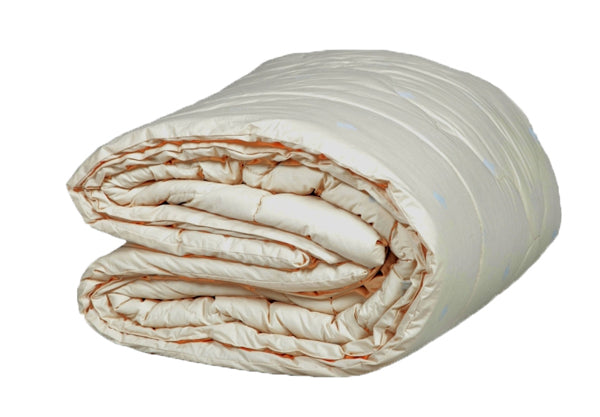Natural Comforter Comparison Guide
Comforters filled with wool, silk or down are wonderfully comfortable and provide many healthy-sleep benefits you won’t find in a polyester comforter. Although these natural comforters share similar qualities, each one is unique in how it feels and performs.
Which natural comforter is right for you? It’s a personal choice based on a number of factors. To start, determine how warm of a comforter you need. It’s important to consider:
- Your bedroom temperature
- How hot or cold you feel during sleep
- Seasonal temperature
- Amount of clothing you wear to bed
Next, think about comfort-feel. Do you sleep best with a weighty comforter or one that’s light and fluffy? Is a soft, drapey comforter your favorite or do you like to snuggle into a poufy one that scrunches easily? Here’s a quick comparison:
- Down: the lightest weight of all with the puffiest loft. Easily wraps and scrunches providing a soft cocoon feel.
- Alpaca: lighter weight than silk or wool with soft, airy loft of medium poof and cozy drape.
- Silk: light weight with a less puffy loft than down. It has a soft drape that contours to your body.
- Wool: medium weight, a bit heavier than silk, with a slightly dense loft that has a cozy blanket feel.
You’ll also need to factor in the comforter’s thermal warmth. Wool, silk and down comforters all have the ability to thermal regulate -- retain and release body heat and moisture while you sleep -- but each fiber does it a little differently. How much thermal warmth a natural comforter provides depends mostly on:
- The amount of fill used in the comforter
- How efficient the fiber is at generating dry, comfortable warmth through the night
- Below is a general comparison of thermal warmth between wool, silk and down comforters:
Wool Thermal Warmth
Wool has an extraordinary ability to rapidly absorb and evaporate body moisture and excess heat. It stores and releases warmth continuously and evenly through the night, without making you feel too hot or cold and clammy.
Fill-weight, the amount of fiber used in a wool comforter, is a guideline for determining the level of thermal warmth. For example:
If you’re a warm sleeper and/or prefer a light to medium cover consider Sleeptek’s Summer-Weight organic wool comforter. The fill-weights for these are: Twin 2.3 lbs., Full 2.9 lbs., Queen 3.3 lbs., King 3.9 lbs.
By comparison, if you tend to sleep cold, prefer a weightier cover or want extra warmth during cold, winter weather Sleeptek’s All Season organic wool comforter is a good choice. You’ll find the fill-weights are heavier than the summer-weight comforter: Twin 3.5 1bs., Full 4.3 lbs., Queen 5 lbs., King 6 lbs.
Alpaca Thermal Warmth
Like wool an alpaca filled comforter does a wonderful job at regulating body heat and wicking away excess moisture. Alpaca fiber is silkier and lighter than wool therefore an alpaca comforter is much lighter than a wool comforter yet it's considered warmer.
Our winter-weight alpaca comforter by Crescent Moon provides comfortable thermal warmth fall, winter and spring without weighing you down. The fill-weights are Twin 3lbs., Full 3.25 lbs., Queen 3.5 lbs. and King 4.5.
Silk Thermal Warmth
Like wool, silk breathes and is a good insulator. It allows excess body heat and moisture to escape, while maintaining a dry, warm sleep environment. Some people find silk’s thermal warmth runs slightly “hotter” than wool but not as warm as down. This is partly due to the silk filament structure. It holds and releases body heat at a different rate than wool and down.
The amount of fill used in a silk comforter is described in a few different ways: by weight, seasonal use and/or TOG rating (Thermal Overall Grade). For example:
- A Summer or light-weight, queen size comforter is typically filled with 250gsm of silk-fill, which equates to a 2 to 4 TOG rating.
- An Autumn or medium-weight, queen size comforter is typically filled with 600gsm of silk-fill, which equates to a 9 to 11 TOG rating.
You might see “momme” used to describe a silk-filled comforter with a silk cover; however, it doesn’t refer to thermal warmth. Instead, silk momme* is the unit of measurement to grade the fabric quality – in this case, the comforter casing.
Down Thermal Warmth
Like wool and silk, down creates a layer of thermal warmth between your body and the comforter. However, it releases excess heat and moisture at a much slower rate than wool and silk. As a result, the thermal warmth tends to build-up through the night. People who consistently sleep cold or need extra warmth during very cold weather find a down-filled comforter to be perfectly comfortable while others feel overheated.
The thermal warmth, or insulating value, of down is a function of both the fill-power rating** and the amount of fiber used to fill the comforter. Fiber quality is an important factor, too.
Rule of thumb: the higher the fiber quality and the more fiber used creates a thicker loft – all combined, the weight and warmth of the comforter increases.
Down, Inc down comforters are good examples of this:
- Our queen size light-weight pure duck down comforter has a 600 fill-power rating with a fill weight of 39 oz. It’s designed for spring through fall use.
- By comparison, our queen size winter-weight down comforter has the same high quality fiber and 600 fill-power rating as the light-weight. But, it’s filled with more fiber so the fill weight increases to 46 oz. As a result, it’s loftier and warmer--great for cold, winters.
Whichever you choose, make sure that it is a natural down comforter. While the right level of thermal warmth contributes greatly to creating a healthy sleep environment, there are additional features of a natural comforter that impact the look, feel and performance:
Wool & Alpaca
- Design: wool and alpaca comforters are made with layers of fluffy wool batting encased in a cotton cover. The comforter is hand-tufted or stitched through all layers to prevent the fiber from shifting.
- Loft: a wool-filled comforter has a fluffy loft that appears less puffy than silk or down. The overall feel is a bit heavier than the other natural fiber comforters but you will not feel weighted down. Allpaca filled comforters feel lighter than wool.
- Allergens: wool and alpaca do the best job at wicking away moisture from your body. The fiber stays dry and naturally deters dust-mites, mold and mildew significantly reducing the build-up of common allergens.
- Chemical-Free: wool and alpaca fiber that is certified organic or processed without harmful chemicals boost the healthy sleep benefits by omitting toxic emissions.
Silk
- Design: a silk comforter is made with layers of spun silk floss encased in a silk or cotton cover. Better quality silk comforters have baffling (interior walls) to keep the fiber in place and block cold air.
- Loft: a silk-filled comforter has an airy, fluffy loft that has moderate puffiness that’s less poufy than down. This creates a drapey, light-weight feel that easily conforms to your body.
- Allergens: silk is good at shedding excess body moisture so the fiber stays dry. Like wool, silk naturally deters dust-mites, mold and mildew.
- Chemical-Free: an Oeko-Tex certified silk comforter ensures the fiber and casing are free of harmful substances -- no skin irritants or toxic outgassing.
Down
- Design: duck and goose down comes from the soft under plumage from the bird. A down comforter is made by encasing the loose fiber in a down proof cotton cover with boxed-stitched compartments, which prevents the fiber from shifting and clumping.
- Loft: duck and goose down comforters have a fluffy loft with superior memory retention to silk and wool. They are the puffiest of all natural comforters. A bit bulkier than silk, a down comforter will feel very light weight.
- Allergens: if you’re sensitive to dust-mite, mold and mildew allergens you might want to opt for a wool or silk comforter rather than down. That’s because down fiber holds onto moisture longer than the other natural fibers. This may cause common allergens to build-up over time.
- Toxin-Free Processing: a certified organic down comforter often means the fabric casing is chemical-free, not the down fiber. So, opt for one that uses sustainable and toxin-free processing methods to harvest and clean the down.
*Momme:The momme measurement is a standard way of measuring silk fabric quality. The measurement is taken from a length of silk plain weave that is 45” wide by 100 yards in length. The length of silk is weighed and the resulting weight in pounds is the momme rating. For example, if a length of silk fabric is 45” inches wide by 100 yards long and weighs 10lbs, it’s graded with a 10 momme. If it weighs 22lbs, it’s graded with a 22 momme.
**Fill-Power: or "loft" is how the quality and size of various down clusters are defined. The larger the down cluster, the higher the fill power rating. Fill power is the number of cubic inches that one ounce of down will fill.





